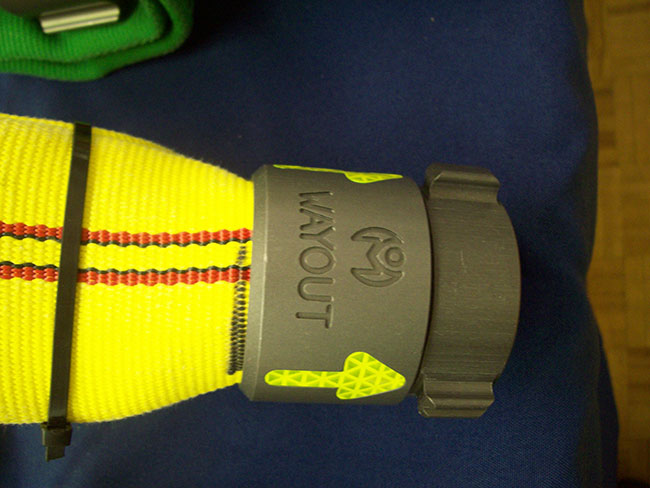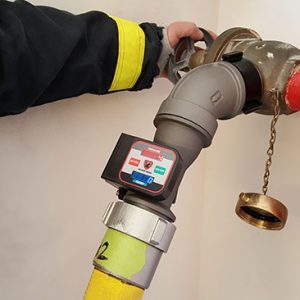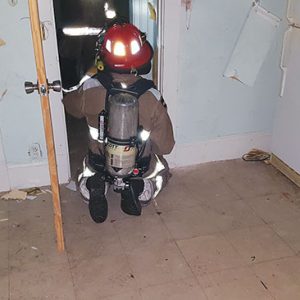
Back to basics: Firefighter survival
By Mark van der Feyst
Features Some hose manufacturers are adding directional arrows on the couplings to help assist with self-rescue. Photo: Mark van der Feyst
Some hose manufacturers are adding directional arrows on the couplings to help assist with self-rescue. Photo: Mark van der Feyst We’re at the point in our look at firefighter survival where we’re going to focus on emergency escape techniques. These are the tactics that any firefighter can employ to rescue themselves from a dire situation. Some of these options may be unorthodox in practice, but they have proven to save the lives of several firefighters.
Donald Abbott’s Project Mayday statistics reported that firefighter survival techniques accounted for 35.5 per cent of mayday rescues for the volunteer fire service and 32.7 per cent for the career side. This means that the firefighter has an exceptionally good chance of saving themselves and being successful. As mentioned previously, these techniques are meant to be a last-ditch effort and not become a standard operational practice. Prevention is the key to firefighter survival by being situationally aware.
To be proficient with these last-ditch techniques, training must be conducted on a regular basis while incorporating consistency. The technique, along with the equipment used, must be practiced together. This will help build muscle memory and develop skill mastery for survival.
The options that are available for use will be following a hose line out, breaching a wall, locating a door to a safe area, or performing an emergency window exit. The two quick options are finding a hose line to follow it out and locating a door to a safe area. Project Mayday reported that following a hose line accounted for 21 per cent of self-rescues in a mayday situation.
The hose line will lead the firefighter in one of two directions – to the fire or the pump. The direction taken will be dictated by reading the hose couplings. There are many sayings that are used to help remember which way to go, such as “smooth, bump, bump, to the pump.” You can choose the one that works best for you. The one I use is called “run away from the woman,” which involves feeling the hose couplings, locating the female coupling, and going in the opposite direction because the female coupling takes you to the fire. The word ‘female’ begins with the letter ‘F’, and so does the word ‘fire.’
Once the hose line and couplings have been located, read them and follow that line out. Do not lose contact with the hose line. Always maintain a firm grip on the hose with your hand. Losing the hose line will be detrimental in your efforts of self-rescue. Some hose manufacturers are adding directional arrows on the couplings to help assist with self-rescue. As you will see in photo 1, the arrows are on the coupling, pointing to the way out. This will require using a flashlight to illuminate the arrows so that they can be seen.
We usually equate following a hose line out to a residential building, but it also applies to any high-rise situation. The difference here will be following it out to a safe area and not to the pump. As shown in photo 2, the safe area will be where the standpipe hook-up will be, which should be one floor below the fire floor.
The other quick option is to locate a door to a safe area. The safe area may be another room, or it could be a door that will lead outside of the structure. The safe area will provide access to a window, which can be used to perform an emergency window escape technique to get out of the structure. To locate the safe area, locating the door handle is going to be the key factor.
As shown in photo 3, door handles are located about three feet up from the floor, roughly the same height as most windowsills. When trying to locate the door handle, be sure to sweep high and low on the wall. This will ensure that you locate the door handle as opposed to patting the wall and missing the door handle entirely. Do not be a wall patter; be a wall sweeper. Once the door has been located, be sure to check the door to make sure it’s not hot. We don’t want to enter another untenable room.
For the wall breach option, you can refer back to the October 2020 issue, where we looked in great detail on how to perform the wall breach. This will also provide access to a safe area that will buy more time for the firefighter. The goal here is to get to another room, locate a window, and then get out.
The techniques discussed above do not require special equipment. A hose, nozzle, hand tools, and a door are all that are needed. These drills can be practiced very easily in a station or a training facility at any time. The key will be consistency with the training and the method chosen to perform the survival option.
Mark van der Feyst has been in the fire service since 1999 and is currently a firefighter with the FGFD. He is an international instructor teaching in Canada, the United States, FDIC and India.
Print this page
Advertisement
- Dispatches: Observations from the field
- Nanaimo fire department, RCMP team investigate at least 20 fires downtown

